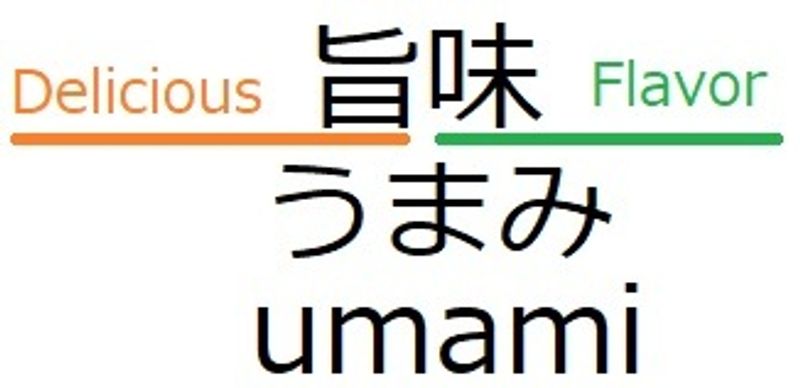Jul 21, 2021
Defining Umami
When I moved to Japan, the term umami was not so well-known. As the discovery that specific taste centers were linked to the flavor only happened in 2006, it's not entirely surprising that America had yet to fully embrace this new term when I left in 2008. Since then, it has to become so common that you can barely watch an episode of any American cooking program without someone bringing it up.

What does umami mean? The kanji means deliciousness (such as umai, the more masculine version of oishii) but in English, that doesn't count as a flavor. In the simplest of terms, the way I have chosen to explain this one starts with savory. Most Internet searches agree that savory is the best basic English to cover the idea of umami, but that isn't where our definition should stop.
What is savory? I have understood this word to mean generally "meaty" in flavor. Funny enough, the word dates back to the 1200s when it merely meant pleasing in flavor, not unlike how umami in kanji is essentially the same as yummy.
In short, sugar is to sweet as meat is to savory. Usually the food item and the description go hand in hand, but can something be savory without meat? Yes, just as some sweets may avoid using sugar. It isn't as common but it can be done. That said, most savory dishes tend to include some kind of meat product.
Umami means savory even in the absence of meat. Things like miso soup or green tea don't have to be full of actual meat in order to have that savory quality. What's interesting to me is that despite the fact that we have the word savory in English, we've agreed to use umami as it applies to taste centers. This is probably partially due to the fact that the first guy to label umami as a distinct flavor separate from sweet, sour, bitter, and salty was a professor at Tokyo Imperial University by the name of Kikunae Ikeda. When he did this in the back in the early 1900s, Americans were eating meat and calling it savory but apparently none of them had the academic background to claim long-lasting fame over it.
A few years ago my husband and I were watching Beyond Sushi, a cartoon series in which a British family moves to Tokyo and enjoys lots of food. What I did not know at the time was that this series was based on a book chronicling the real-life adventures of Michael Booth as he and his family tried all the food they could in one season in Japan.
In the episode specifically about umami , the main character asks what umami means and when the Japanese characters are asked to explain it, instead of providing any kind of translation, they begin by handing the protagonist a cup of green tea followed by so many different kinds of food. All the while, they keep repeating something to the effect of: "This is Umami. Don't you get it?"
While experience is one way to create a strong understanding, this kind of situation would be tedious for the average foreigner. Unless you have a whole evening to try tea and soup at the behest of your baffling cohort, and don't mind filling up on whatever they serve you, this wouldn't be the most convenient method of communicating the idea of umami no matter what their Japanese level is.
After watching other Japanese food enthusiasts on YouTube attempt to explain the apparently complex nature of umami, I now fully believe that this inundating with soup and tea could very well have happened. It appears that many Japanese folks in particular have trouble defining this term in English.
About ten years ago, I was given a proofreading assignment that included a questionnaire regarding samples of a specific kind of food. The writers of this questionnaire were pretty good with words like salty, making questions like "How salty was the sample?"
The rest of the flavors went by just fine until they got to umami. Suddenly, they completely lost all sense of English, garbling the sentence so badly that the only way I would know that they weren't asking someone named Umami was from the context of the previous questions and knowing that umami had something to do with taste.
That kind of experience raised my big issue with the term. So many Japanese people historically have regarded it with such zeal that any attempts to really communicate meaning get lost in the fervor.
What I didn't realize when I started writing this piece is that there has been a lot of study and thought into what makes umami and how it operates since I was last so frustrated with the translational aspect.
It turns out that the impact of umami can be magnified by combining specific compounds in specific ways. All of this is outlined and explained fairly well at the Umami Information Center website. While it is nice to see scientific terminology added to this flavor explanation, I've also seen quite a few youtubers insisting that umami only means yumminess right before giving their tips on how to use glutamic acid for best results. The definition still stinks, even when science is also present.
The word is common enough in the states now that it even appears as one of the characters personifying taste in Waffles and Mochi, the children's show recently released on Netflix in which Michelle Obama along with a score of mostly puppet characters investigate many different kinds of food. Umami is presented as a confident if short bombshell type who loves things savory. I am so glad they chose to use words we had in English instead of asking the audience of young children to guzzle green tea and dashi until they get the idea.



0 Comments